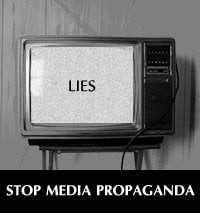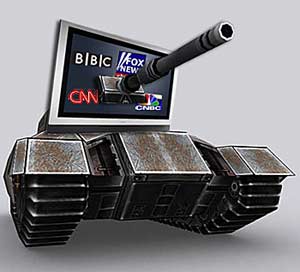Peddler of Iraq War Lies now Pushes Lies on Urkaine to Drum Up Confrontation with Russia

War Lies Sold Again By the Same Old Liars …
Intelligence regarding Syria is arguably being manipulated even more blatantly than intelligence on Saddam and Iraq.
Media coverage of Syria and Ukraine is as bad as it was of the Iraq war … or worse.
Indeed, it is largely the same knuckleheads in government and in media who are pushing the lies.

Former Associated Press and Newsweek reporter Robert Parry notes today that some of the core Iraq war lies, Syria lies and lies about Ukraine were all penned by New York Times reporter Michael Gordon:
There is now a pattern to New York Times “investigative” stories that seek to pin the blame on some nefarious foreign enemy, as in the 2002 article on Iraq buying aluminum tubes for nuclear centrifuges; the 2013 “vector analysis” tracing sarin-laden rockets to a Syrian military base; and now a photographic analysis proving that Russian soldiers are behind unrest in eastern Ukraine.
All these stories draw hard conclusions from very murky evidence while ignoring or brushing aside alternative explanations. They also pile up supportive acclamations for their conclusions from self-interested sources while treating any doubters as rubes. And, these three articles all involved reporter Michael R. Gordon.
The infamous aluminum tube story of Sept. 8, 2002, which Gordon co-wrote with Judith Miller, relied on U.S. intelligence sources and Iraqi defectors to frighten Americans with images of “mushroom clouds” if they didn’t support President George W. Bush’s invasion of Iraq. The timing played perfectly into the administration’s advertising “rollout” for the Iraq War.
Of course, the story turned out to be false and to have unfairly downplayed skeptics of the nuclear-centrifuge scenario. The aluminum tubes actually were meant for artillery, not for centrifuges. But the article provided a great impetus toward the Iraq War, which ended up killing nearly 4,500 U.S. soldiers and hundreds of thousands of Iraqis.
Gordon’s co-author, Judith Miller, became the only U.S. journalist known to have lost a job over the reckless and shoddy reporting that contributed to the Iraq disaster. For his part, Gordon continued serving as a respected Pentagon correspondent.
Gordon’s name also showed up in a supporting role on the Times’ botched “vector analysis” of Sept. 17, 2013, which nearly helped get the United States into another Mideast war, with Syria. That story traced the flight paths of two rockets, recovered in suburbs of Damascus after the Aug. 21 sarin gas attack, back to a Syrian military base 9.5 kilometers away.
The article became the “slam-dunk” evidence that the Syrian government was lying when it denied launching the sarin attack that killed several hundred people.
However, like the aluminum tube story, the Times’ ”vector analysis” also ignored contrary evidence …. [Background]
Now, the New York Times has led its Monday editions with an article supposedly proving that Russian military special forces are secretly directing the popular uprisings in eastern Ukraine…
The Times based its story on grainy photographs provided by the Kiev regime supposedly showing the same armed “green men” involved in actions with the Russian military earlier and now with the pro-Russian protesters who have seized government buildings in towns in eastern Ukraine.
The Times reported, “Now, photographs and descriptions from eastern Ukraine endorsed by the Obama administration on Sunday suggest that many of the green men are indeed Russian military and intelligence forces — equipped in the same fashion as Russian special operations troops involved in annexing the Crimea region in February. Some of the men photographed in Ukraine have been identified in other photos clearly taken among Russian troops in other settings.”
The Times apparently accepts the photos as legitimate in terms of where and when they were taken, but that requires first trusting the source, the post-coup regime in Kiev which has a strong motive for making this argument as a prelude to violently crushing the eastern Ukrainian protests.
Secondly, one has to believe that the fuzzy photographs of the circled faces are the same individuals. They may be, but it is difficult to be sure from what is displayed. The principal figure shown is a man with a long beard and a cap sometimes pulled down over his forehead. He could be a Russian special forces soldier or a character from “Duck Dynasty.”
And the resemblance of some uniforms to those worn by Russian soldiers is also circumstantial, since military gear often looks similar or it could have been sold to civilians, or the men could be veterans who kept their old uniforms after leaving the military. The fact that these men are adept at handling weapons also could mean that they have prior military experience, not that they are still active.
For the Times to cite the Obama administration’s endorsement of the Kiev regime’s claims as some kind of verification is also silly. Anyone who has followed the Ukraine crisis knows that the U.S. government is wholeheartedly on the side of the post-coup regime, trumpeting its propaganda and dismissing any counterclaims from the Yanukovych camp or from Moscow.
There’s other silliness in the Times article, such as the notion that the Russians are unusual in “masking” their special forces when U.S. military and intelligence services have been doing the same for decades.
***
Is it possible that the Times’ reporters, including Pentagon correspondent Gordon, don’t know that U.S. Special Forces and CIA officers routinely grow beards and wear local garb to blend in when they are operating in places like Afghanistan, Iraq, Central America, etc.?
When I was covering Central America policy in the 1980s, I knew American mercenaries, including former U.S. Special Forces soldiers, who provided training and other assistance to the region’s security forces. Sometimes, these veterans coordinated their actions with the U.S. government and sometimes they were simply making money.
***
Plus, you have to wonder how skillful the Russians really are at “masking” if they have their special forces troops wear uniforms that can be so easily traced back to Russia.
***
The Times should have learned from its previous blunders and taken care to include alternative scenarios or point to evidentiary holes in what the Kiev regime claimed. Instead, the Times has again acted like a prosecutor determined to make a case, not a fair-minded judge weighing the evidence.
It is also an indictment of the Times’ professionalism that this newspaper of record can’t seem to detect neo-Nazis in the post-coup regime, when some have open histories of pro-Nazi behavior, while it goes to dubious lengths to discredit the eastern Ukrainians who are resisting the imposition of authority from an unelected administration in Kiev.
Just like the “aluminum tube” story that justified killing so many Iraqis and the “vector analysis” that almost unleashed a devastating U.S. bombing campaign on Syria, the Times’ “green men” piece may be the prelude to a bloodbath in eastern Ukraine.
The powers-that-be are desperate for a war to distract the population.
And the mainstream media (and large “alternative” media outlets) are always pro-war, and happy to beat the war drums as loudly as they can.
So they will push lie after lie …


